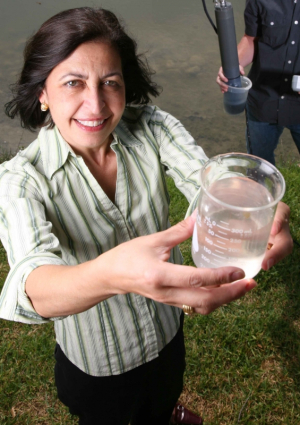| Researchers Win $500k Grant to Write Structural Material Design Specs Before structural engineers can include composite materials in roads and bridges, design guidelines and specifications that outline how their use in infrastructure must be written. That’s the task Distinguished Professor of Civil Engineering DJ Belarbi and his colleagues, assistant professors Mina Dawood and Bora Gencturk, have taken up. The team is developing design guidelines and specifications for the use of prestressed carbon fiber reinforced polymers (CFRPs) in the construction of new bridges. To conduct this work, they recently won a three-year, $500,000 grant from the National Cooperative Highway Research Program, a group administered by the National Academy of Sciences and voluntarily funded by state transportation boards. News
Computer-aided Engineering for Oil and Gas Production: Research Could Revolutionize Industry TcSUH Scholarship Connects Students with Biomedical Sciences
Rifai Named “Environmental Professional of the Year” Videos: Why Should You Invest In A New Engineering Building For The Cullen College? Catalysis Research Gest a Boost through Joint U.S./Israel Grant |
 |
| UPDATE INFORMATION SUBMIT CLASS NOTES GIVE FEEDBACK SUPPORT UH |
Other News
UH Space Architects Help Design Houston’s Proposed Spaceport
Photos: Undergraduate Research Day 2013
NSF Grant Funding Atomic-Scale Patterning Research
Pediatric Brain Cancer Research Wins Funding
Photos: Engineering Leadership Board Reception & Dinner
Opportunities for Engineering Entrepreneurs You Never Knew Existed
College Mourns Passing of Michael Pao, Distinguished Research Professor & NAE Member
Cullen College Alum Name to UH System Board of Regents
Photos: Civil & Environmental Engineering Alumni Luncheon
BMI Workshop Recounted in IEEE Pulse
Upcoming Events
Time-Resolved Imaging of Nanosecond Laser Ablation Processes
Thursday, November 7
2:30 pm to 3:30 pm
Department of Mechanical Engineering, L2D2
N207 Engineering Building 1
University of Houston
UH Sales Career Fair
Thursday, November 7
3:00 pm to 6:00 pm
UH Hilton Hotel
University of Houston
UH Energy Symposium Series
Thursday, November 12
6:30 pm to 8:00 pm
UH Hilton Hotel, Waldorf-Astoria Ballroom
University of Houston
|
EGR HOME | EGR NEWSROOM | EGR ALUMNI ASSOCIATION | PARAMETERS | THE COUGAR ENGINEER UH Cullen College of Engineering, E421 Engineering Bldg 2, Houston TX 77204-4007 | 713-743-4200 |


